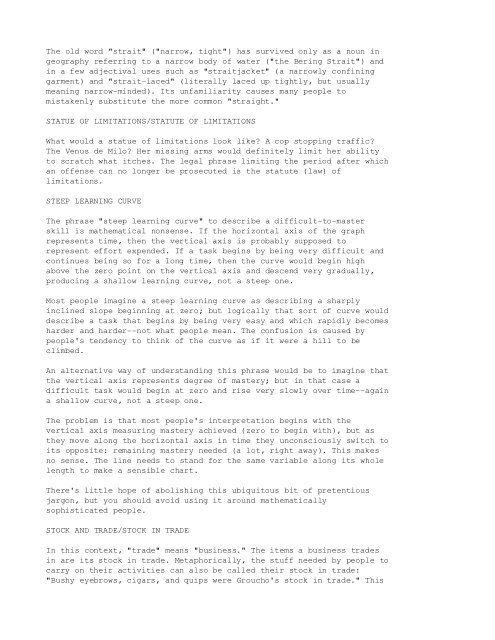Common_Errors_in_English_usage
Common_Errors_in_English_usage
Common_Errors_in_English_usage
Create successful ePaper yourself
Turn your PDF publications into a flip-book with our unique Google optimized e-Paper software.
The old word "strait" ("narrow, tight") has survived only as a noun <strong>in</strong><br />
geography referr<strong>in</strong>g to a narrow body of water ("the Ber<strong>in</strong>g Strait") and<br />
<strong>in</strong> a few adjectival uses such as "straitjacket" (a narrowly conf<strong>in</strong><strong>in</strong>g<br />
garment) and "straitlaced" (literally laced up tightly, but usually<br />
mean<strong>in</strong>g narrowm<strong>in</strong>ded). Its unfamiliarity causes many people to<br />
mistakenly substitute the more common "straight."<br />
STATUE OF LIMITATIONS/STATUTE OF LIMITATIONS<br />
What would a statue of limitations look like? A cop stopp<strong>in</strong>g traffic?<br />
The Venus de Milo? Her miss<strong>in</strong>g arms would def<strong>in</strong>itely limit her ability<br />
to scratch what itches. The legal phrase limit<strong>in</strong>g the period after which<br />
an offense can no longer be prosecuted is the statute (law) of<br />
limitations.<br />
STEEP LEARNING CURVE<br />
The phrase "steep learn<strong>in</strong>g curve" to describe a difficulttomaster<br />
skill is mathematical nonsense. If the horizontal axis of the graph<br />
represents time, then the vertical axis is probably supposed to<br />
represent effort expended. If a task beg<strong>in</strong>s by be<strong>in</strong>g very difficult and<br />
cont<strong>in</strong>ues be<strong>in</strong>g so for a long time, then the curve would beg<strong>in</strong> high<br />
above the zero po<strong>in</strong>t on the vertical axis and descend very gradually,<br />
produc<strong>in</strong>g a shallow learn<strong>in</strong>g curve, not a steep one.<br />
Most people imag<strong>in</strong>e a steep learn<strong>in</strong>g curve as describ<strong>in</strong>g a sharply<br />
<strong>in</strong>cl<strong>in</strong>ed slope beg<strong>in</strong>n<strong>in</strong>g at zero; but logically that sort of curve would<br />
describe a task that beg<strong>in</strong>s by be<strong>in</strong>g very easy and which rapidly becomes<br />
harder and hardernot what people mean. The confusion is caused by<br />
people's tendency to th<strong>in</strong>k of the curve as if it were a hill to be<br />
climbed.<br />
An alternative way of understand<strong>in</strong>g this phrase would be to imag<strong>in</strong>e that<br />
the vertical axis represents degree of mastery; but <strong>in</strong> that case a<br />
difficult task would beg<strong>in</strong> at zero and rise very slowly over timeaga<strong>in</strong><br />
a shallow curve, not a steep one.<br />
The problem is that most people's <strong>in</strong>terpretation beg<strong>in</strong>s with the<br />
vertical axis measur<strong>in</strong>g mastery achieved (zero to beg<strong>in</strong> with), but as<br />
they move along the horizontal axis <strong>in</strong> time they unconsciously switch to<br />
its opposite: rema<strong>in</strong><strong>in</strong>g mastery needed (a lot, right away). This makes<br />
no sense. The l<strong>in</strong>e needs to stand for the same variable along its whole<br />
length to make a sensible chart.<br />
There's little hope of abolish<strong>in</strong>g this ubiquitous bit of pretentious<br />
jargon, but you should avoid us<strong>in</strong>g it around mathematically<br />
sophisticated people.<br />
STOCK AND TRADE/STOCK IN TRADE<br />
In this context, "trade" means "bus<strong>in</strong>ess." The items a bus<strong>in</strong>ess trades<br />
<strong>in</strong> are its stock <strong>in</strong> trade. Metaphorically, the stuff needed by people to<br />
carry on their activities can also be called their stock <strong>in</strong> trade:<br />
"Bushy eyebrows, cigars, and quips were Groucho's stock <strong>in</strong> trade." This





